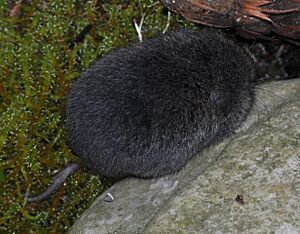Townsend's vole facts for kids
Quick facts for kids Townsend's vole |
|
|---|---|
 |
|
| Conservation status | |
| Scientific classification | |
| Genus: |
Microtus
|
| Species: |
townsendii
|
 |
|
| Synonyms | |
|
|
The Townsend's vole (Microtus townsendii) is a small rodent that looks a bit like a mouse. It's part of the Cricetidae family, which includes hamsters and lemmings. You can find these voles in grassy areas of British Columbia in Canada, and in the states of Washington and Oregon in the United States.
The name Microtus comes from Greek words meaning "small ear." The second part of its name, "Townsend's," honors John Kirk Townsend. He was an American naturalist who first collected a sample of this animal in 1835.
Contents
What Does a Townsend's Vole Look Like?
Townsend's voles are some of the biggest voles in North America. They can grow to be about 169 to 225 mm (6.7 to 8.9 in) long, including their tail. Their tail itself is about 48 to 70 mm (1.9 to 2.8 in) long. These voles usually weigh between 48 to 73 g (1.7 to 2.6 oz).
They have wide ears that stick out and are easy to see above their fur. Their fur is thin and a bit rough. The top of their body is dark brown, with many black-tipped hairs. Their underside is a lighter color. Their feet are a dark gray, and their tail is black on top and dark brown underneath. Young voles are often darker than adults. They have dark gray undersides and black tails and feet.
Where Do Townsend's Voles Live?
Townsend's voles live in the far western part of North America. Their home range stretches from Vancouver Island, British Columbia, south through Washington state and Oregon. It goes all the way to Humboldt Bay in California.
You can find them from sea level up to high places. They live at altitudes of 1,830 m (6,000 ft) in the Olympic Mountains. In the Cascade Range, they can be found up to 915 m (3,002 ft) high. These voles prefer wet places like wet meadows, marshes, and flood plains. They also like areas with lots of thick plants and salt marshes.
Sometimes, there can be a huge number of voles in one area. This means they might take up space that other animals would use. Because they reproduce quickly, they become an important food source for many other animals.
How Townsend's Voles Live
Townsend's voles live in burrows underground. They also make special paths, called runways, through the plants where they live. These runways are used all year by many generations of voles. They can be 2.5 to 5 cm (1 to 2 in) deep.
In the summer, voles might use the thicker plant cover to move around more freely. They often leave their droppings in these runways. Sometimes, large piles of droppings, called latrines, can form. These can be quite big, up to 18 by 8 cm (7 by 3 in) wide and 13 cm (5 in) tall.
Voles build their nests on the ground or on small mounds. This helps them live in areas that might flood sometimes, as their burrows could be underwater. Both underground and surface nests are made from grasses.
What Do Townsend's Voles Eat?
Townsend's voles eat soft, green plants. Their diet includes things like rushes, tules, grasses, sedges, and horsetails. They also enjoy clovers, alfalfa, blue-eyed grass, and purple-eyed grass.
They also collect and store the round roots of American wild mint. They eat these roots during the winter, even when there's plenty of fresh green food available.
Life Cycle and Reproduction
Townsend's voles have their babies between February and October. The mother carries her babies for about 23 days before they are born. A mother vole can have anywhere from one to nine babies at a time. On average, she has about four babies. Older, larger females tend to have more babies in each litter.
The young voles are ready to stop drinking their mother's milk when they are about sixteen days old.
Conservation Status
Townsend's voles live across a wide area. Their numbers can go up and down a lot. However, over a long time, their population seems to stay steady. In some places, there are many voles. Scientists have counted as many as eight hundred voles in an area the size of a hectare.
There are no major threats known for this species. Because of this, the International Union for Conservation of Nature says that the Townsend's vole is of "least concern" for conservation. This means they are not currently at risk of disappearing.


